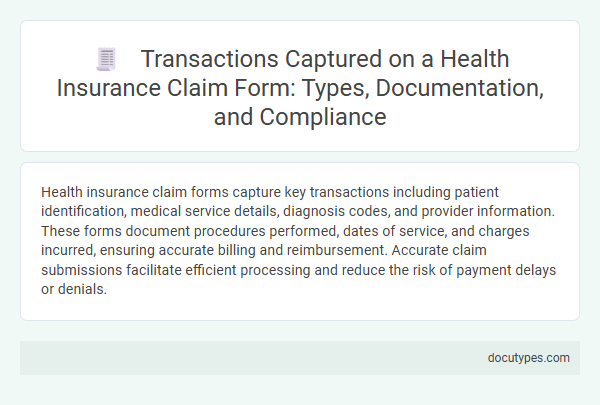Health insurance claim forms capture key transactions including patient identification, medical service details, diagnosis codes, and provider information. These forms document procedures performed, dates of service, and charges incurred, ensuring accurate billing and reimbursement. Accurate claim submissions facilitate efficient processing and reduce the risk of payment delays or denials.
Introduction to Health Insurance Claim Transactions
Health insurance claim forms capture essential transactions necessary for processing medical service payments. These forms facilitate communication between healthcare providers and insurance companies to ensure accurate reimbursement.
- Patient Information - Includes demographic details and identification needed to verify the insured individual.
- Service Details - Records descriptions of medical procedures, diagnoses, and treatment dates.
- Billing Information - Contains itemized charges, provider identification, and payment authorization data.
Key Types of Transactions on Claim Forms
| Transaction Type | Description | Key Data Elements |
|---|---|---|
| Patient Information | Details about the insured individual receiving medical services. | Name, Date of Birth, Insurance ID Number, Address |
| Provider Information | Identification of the healthcare provider delivering the services. | Provider Name, National Provider Identifier (NPI), Address, Tax Identification Number |
| Insurance Details | Information about the health insurance plan covering the patient. | Insurance Company Name, Policy Number, Group Number, Plan Type |
| Medical Services | Descriptions and codes of healthcare services provided. | Current Procedural Terminology (CPT) Codes, Date of Service, Units of Service |
| Diagnosis Codes | Codes identifying the patient's medical conditions related to the services. | International Classification of Diseases (ICD-10) Codes |
| Charges and Payments | Financial information regarding billed amounts and payments made. | Itemized Charges, Amount Billed, Amount Paid, Patient Responsibility |
| Authorization and Referrals | Information on prior authorizations or referrals necessary for coverage. | Authorization Numbers, Referral Codes |
| Claim Status Details | Updates on the processing and adjudication of the claim by the insurer. | Claim Number, Date of Submission, Claim Adjudication Status |
Essential Documentation for Each Transaction Type
Health insurance claim forms capture various transaction types including patient information, medical procedures, and payment details. Essential documentation for patient information involves verifying personal and insurance details, while medical procedures require accurate CPT or ICD codes. Your responsibility includes ensuring all documentation aligns with transaction types to guarantee claim accuracy and timely reimbursement.
Patient Information and Verification Procedures
Health insurance claim forms capture essential patient information such as full name, date of birth, gender, and insurance policy number. Accurate patient details ensure proper identification and facilitate smooth processing of medical claims.
Verification procedures include validating the patient's eligibility, coverage status, and coordination of benefits through insurance provider databases. These steps prevent claim denials and reduce errors in billing and reimbursement processes.
Provider Data and Identification Requirements
Health insurance claim forms capture detailed provider data essential for processing medical transactions accurately. Accurate provider identification ensures correct billing, reimbursement, and legal compliance in health insurance claims.
- Provider Name and Address - This includes the full legal name and physical location of the healthcare provider submitting the claim.
- National Provider Identifier (NPI) - A unique 10-digit identification number assigned to healthcare providers used for standardized identification across claims.
- Tax Identification Number (TIN) - Required for tax reporting and provider verification in insurance transactions on the claim form.
Coding Standards: ICD, CPT, and HCPCS
Health insurance claim forms capture medical transactions using standardized coding systems to ensure accurate billing and reimbursement. Key coding standards include ICD for diagnoses, CPT for medical procedures, and HCPCS for additional healthcare services and supplies.
ICD codes classify diseases and health conditions to describe patient diagnoses in detail. CPT codes document medical, surgical, and diagnostic services performed by healthcare providers. HCPCS codes cover items not included in CPT, such as ambulance services and durable medical equipment, facilitating comprehensive claim processing.
Claims Submission and Processing Workflow
Health insurance claim forms capture essential transactions related to patient care and provider billing. These transactions facilitate accurate claims submission and efficient processing within healthcare systems.
- Patient Information - Includes personal details, insurance policy numbers, and coverage data for identification and verification.
- Service Details - Documents medical procedures, diagnoses, service dates, and provider information to justify billing.
- Payment Information - Records charges, adjustments, and amounts billed to ensure proper reimbursement processing.
The collected transactions streamline claims adjudication and support timely payment to healthcare providers.
Common Errors and Compliance Risks
Which transactions are typically captured on a health insurance claim form? Health insurance claim forms record patient information, provider details, service codes, and payment data. Accurate capture ensures proper reimbursement and reduces compliance risks.
What are common errors found on health insurance claim forms? Frequent mistakes include incorrect patient identification, inaccurate procedure codes, and missing provider signatures. These errors can lead to claim denials and delayed payments.
How do errors on claim forms affect compliance? Incomplete or inaccurate claims may trigger audits and legal penalties for healthcare providers. Maintaining data accuracy is essential to comply with regulations such as HIPAA and CMS guidelines.
Which compliance risks are associated with health insurance claim submissions? Risks include submitting fraudulent claims, duplicate billing, and failure to document services properly. These issues can result in significant financial penalties and loss of licensing.
What steps reduce errors and compliance risks in health insurance claims? Implementing thorough staff training, using advanced billing software, and conducting regular internal audits improve claim accuracy. These practices help safeguard revenue and uphold regulatory standards.
Regulatory Requirements and Data Privacy
Health insurance claim forms capture transactions related to patient demographics, medical diagnoses, procedures performed, and billing information. Regulatory requirements mandate accurate documentation to ensure compliance with healthcare laws such as HIPAA, protecting patient rights and data integrity. Your personal health information is safeguarded through stringent data privacy measures, limiting access to authorized personnel only.
Which Transactions Are Captured on a Health Insurance Claim Form? Infographic

